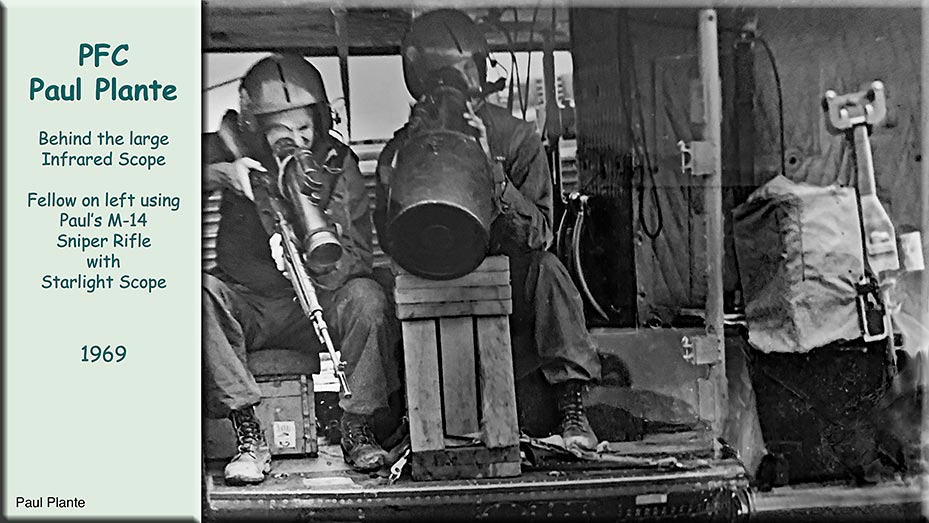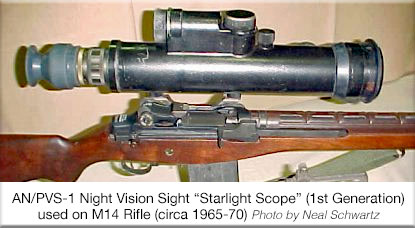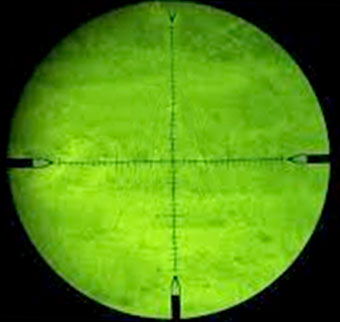

Nighthawk Sniper - 1969
by Paul Plante
index - How It Started, the Starlight Scope, Fade Out Factor, Kills, Silver Star , 1/5th Bobcats Report, Request Input, comments
see Nighthawk Stories: Minigun 69, Twin 60's 70-71, 1971, Aug 71, Allen Video, Bored Crew, Avn Digest Article, Marcinkowski Video,
.....................................................................................................................................................................................
PFC Paul Plante (1969) was an infantryman who volunteered to carry an M-14 with Sniper Scope
and go on night missions with the Nighthawks of Little Bear and Centaur units.
 How it Started: I was an infantryman with Company A, 2/12 Infantry Battalion (Warriors) in 1969. One day they came looking for volunteers to take the fight to Charley at night with a helicopter and a sniper gunner with a starlight scope; I jumped at the chance. It was a new concept, to stir up trouble with the enemy who was used to having the night to themselves. A lot of details had to be worked out as the mission developed. I was initially attached to the "Little Bears" 25th Avn Battalion as Huey door gunner/sniper and later on with the Centaurs, D Troop (Air), 3/4 Cav.
How it Started: I was an infantryman with Company A, 2/12 Infantry Battalion (Warriors) in 1969. One day they came looking for volunteers to take the fight to Charley at night with a helicopter and a sniper gunner with a starlight scope; I jumped at the chance. It was a new concept, to stir up trouble with the enemy who was used to having the night to themselves. A lot of details had to be worked out as the mission developed. I was initially attached to the "Little Bears" 25th Avn Battalion as Huey door gunner/sniper and later on with the Centaurs, D Troop (Air), 3/4 Cav.
 I continued to live with my infantry unit but showed up at night on the flight line with my M-14 rifle with a snipers starlight scope. The M-14 was known for its accuracy and used by trained infantry unit snipers. It had been issued to me by my unit.
I continued to live with my infantry unit but showed up at night on the flight line with my M-14 rifle with a snipers starlight scope. The M-14 was known for its accuracy and used by trained infantry unit snipers. It had been issued to me by my unit.
I was a PFC, the guy with the gun and the scope. I don't know originally how I was accounted for on those missions but I became known as the Nighthawk Sniper. I was flying every night, usually late, sometimes getting back around 3:00 am. At some point, since I was flying so much, whatever paperwork had to get done was done so my time was then logged as crew, and I was eligible for the Air Medal.
How does the Starlight Scope work?:
The starlight scope somehow enhances ambient light at night through electronics. What you see is very much like looking into a fish tank in terms of color - sort of greenish, although what you see is the same detail as if looking though a regular scope.
An infrared scope sight is different. It has to have an infrared light source which is like a flashlight tuned to only emit in the IR range. Some Nighthawk ships mounted the IR capable light off of a main battle tank to paint the targets with infrared. Then use viewing devices like IR binoculars or an IR Scope.
The starlight scope can also see infrared light from an infrared light source such as a tank spotlight in IR mode. It really brightens things up in the starlight scope.
Without that IR source to create the IR beam of light, the infrared scope can't see at night, and the IR scope isn't going to be able to see outside of that cone of light. If someone had an IR scope, the starlight scope could pick up that IR beam, but nothing is emitted by the starlight scope, so you can't be tracked back like with the IR.
If in a ground situation somebody with a starlight scope, or IR scope which needed the illuminator, was using the illuminator in what they call an "active" mode, somebody with a starlight scope in "passive" mode would pick the beam of that illuminator up clearly and could then follow it back to pop the weapon holder, which is why IR scopes went out of vogue when the starlight scope came into being.
In the photo at the start of the article, which was taken by the Little Bears very early on for a press release of some sort, I am on what was called a crew-served starlight, the big starlight scope. That set-up was scrapped almost immediately for a host of reasons having to do with how to communicate between too many people.
Kind of embarrassing, actually, because the guy on the rifle in that picture proved to be overly excitable and panicky as in "oh my God what do we do now," that as we passed over a column of Charlies that I could see in the big scope, but he didn't see because he apparently was looking somewhere else.
In the meantime, you are moving in some direction and the target is perhaps moving in another, and the pilots are blind to that, so it was a real cluster ****, like a game of blind-man's bluff.
So we went to the single rifleman, me (I was 23 and not excitable), essentially sitting where I was with the big starlight, which was then gone, facing the same way, rifle forward, not towards the rear, and then we had to work out a system of communication, which was much simpler. I would find targets, mark them with tracers and the gunships would go to work.
Think about it for a moment. On a Charley model or a cobra, you were firing towards your front, and had a sight or pipper to guide you in on your target. In essence, whether you consider it or not in infantry terms, where your sight is, is the "strike of your bullet". Not so in my mission where the rifle is out the side of the ship. The crew of the nighthawk ship to keep the guns on target had to roll sideways like the Puff the Magic Dragon C-47s. The pilots had to do some mental geometry.
It was like being tethered to the strike of the bullet by a 300 foot radius (we flew at 300 feet which many pilots didn't seem to like). When a target was acquired, it required the pilot to immediately climb and turn to the left so the ship was in essence pivoting around the strike of the bullet.
The shooter was essentially in a fixed posture, and the pilot had to maneuver the helicopter with that in mind, which again, some pilots thought tedious.
As a shooter, the first thing that impresses in your mind is don't shoot the skids and don't shoot the main rotor blade, so there wasn't really a lot of movement that the gunner could do, especially when all the shooting was down. I suppose it is a variation on gun ships or cobras "rolling in" on a target - the mental gymnastics of manipulating the controls in such a way as to bring a target into view and then keep it there.
The Fade Out Factor: When flying alongside the mini-gun, or even the muzzle flash of the M-60 on the helicopter, that light would somehow overpower the scope and it would go white so you couldn't see a thing. This was a serious limitation. Another example happened one night when the enemy opened up on us with a 51 cal anti aircraft weapon. I knew something was up, when all of a sudden, my scope went white and I lost the target. When I pulled back, there were all those very bright tracers streaming past underneath us. The light was sufficient to foul my scope, so yes, fade out was a serious issue.
Were kills recorded?
I don't know for several reasons - one, we didn't linger around to see who might have been moving or not, and two, this was happening out in the free-fire zones, and we didn't have exact pin-point locations as to where the contact was made, so nobody was going out in daylight to beat around the bushes to see if any bodies were laying around.
Remember that when I started, the mission, if you will, was perhaps a form of retaliation - bring the fight to them at night, because twice at night in two nights in succession, we had been mauled in company strength by them.
Ambush patrols were set up, but that is luck of the draw.
A flying ambush, which in essence we were at the beginning, was a way around that.
It turned out, as things in the military go, as we had some early success disrupting movement and harassing Charley, that word got out that a "new tool" existed, and then ground units started politicing as to how the tool was to be used to their advantage, which had the pilots a bit pissed off, since they were being vectored here and there by the Battalion Tactical Operations Center.
 The Silver Star Mission:
The Silver Star Mission:
 On the evening of 13 June 1969 (Friday the 13th no less), somewhere around midnight, I was flying Nighthawk with the Centaurs. We flew into an ongoing firefight where a Little Bear helicopter had been shot down by an RPG and was burning. It was some distance from the actual firefight. It might have been near Phouc My, which was between Cu Chi and Trang Bang.
On the evening of 13 June 1969 (Friday the 13th no less), somewhere around midnight, I was flying Nighthawk with the Centaurs. We flew into an ongoing firefight where a Little Bear helicopter had been shot down by an RPG and was burning. It was some distance from the actual firefight. It might have been near Phouc My, which was between Cu Chi and Trang Bang.
The helicopter I was on was a Centaur 3/4 Cav Nighthawk ship and those guys could really fly. They had to run the same gauntlet the Little Bear ship did when it got shot down. A wild ride that was.
While the fire fight was on-going, we came in and the Centaur ship extracted wounded, including the crew of the downed Little Bear ship. They all had survived the crash. The Little Bear ship was nothing but a white-hot pile of ashes still burning when we came roaring in, so there would be nothing left of it to recover.
I got off the ship, helped load wounded and then stayed on the ground until the fight was over, getting wounded in the face in the process. Later the 1st Brigade Commander sent his Loach out for me and the Centaur crew chief, who also stayed behind. Never got to talk to the unit that was in contact. see the Bobcat unit history report.
When it was over, somebody came over, found us and told us to go to a certain spot because the Brigade Commander was sending his loach out to pick myself and the Centaur crew chief up.
I believe the Centaur aircraft commander and pilot were awarded DFC's for that daring rescue.
If I have it right, that Centaur Nighthawk ship took out something like 11 people that night, including the surviving Little Bear crew. That was one wild ride on the way in and how those guys could fly, and it was one of many incredible things over there that nobody knows about. I later met the rescued crew of the downed Little Bear, and I can tell you that they were very thankful for the Centaurs. I received a personal letter of commendation from Major Addicott, the CO of the Little Bears afterwards and met the crew of the Little Bears ship. Unfortunately that crew was killed later when their ship was shot down. My tour with the Centaurs ended shortly after that night.
As a result of that rescue of the Little Bear crew, I was adopted by the Little Bears so to speak, and Major Addicott of the Little Bears worked a deal with LTC Mann of the 2/12 to have me transferred into the Little Bears as a regular door gunner. From there, I got drafted into flight operations for the Little Bears.
Bobcat 1/5th (Mech), 25th Inf Div, Unit History Report:
On June 13, 1969 at 2120 hours, an ambush patrol from Company A engaged an enemy squad just north of Phuoc My at XT 587168. One Bobcat was wounded in the exchange, which killed several enemy soldiers.
At 2330 hours, a night combat patrol from Company A called in artillery on a suspected enemy position at XT 571164. The enemy responded with RPG fire which hit one APC, wounding four Bobcats.
Helicopter gunships were called into the area and one of them was shot down, wounding the four crew members.
In a sweep of the area at first light, enemy bodies, weapons and equipment were policed up.
Input Requested:
What is of interest to me is the mindsets of the various players involved in the evolution of the Nighthawk mission. What was on the minds of the helicopter pilots and crew versus the mind of the grunts on the ground. Do you have some input?
As a grunt, I was essentially responsible for myself and the basic infantry command to clear your front and suppress enemy fire.
On the other hand, the helicopter aircraft commander and pilot were responsible for an expensive piece of government property and the lives of their crew.
Might that cause some conflict?
Some pilots made it clear they thought the mission was stupid and fool-hardy because of the vulnerable position it put the bird in. Others may not have cared for having a PFC be in charge of guiding the aircraft.
I would like to hear from anyone about what they remember and how they felt about the mission. Please contact me through the Webmaster at powellcentaur@mail.com
Comments:
From Stan Allen: Plante's name is familiar, but I cannot remember any more about him. It is very possible that he flew with me several times. The crews changed almost nightly. As to light man and other observers. depending on the mission. I do remember a guy with an M-14 with a night scope on it. I think that he told me that he had it sighted in for 1000 feet and 90 knots. I think he was very effective with it. I do not remember his name or any of the dates. Dates did not mean much at that time . You just did your job from night to night, just to get ready for the next night.
From Paul Plante: One of the original concepts of the Nighthawk Mission was that we thought that we could fly into a firefight and bring specific fire onto targets like RPG gunners or MG positions highly visible to us in the air. What foiled that concept was our place in the pecking order of the "orbit," where fast movers and gun ships had precedent or priority which resulted in us being squeezed out as we were thought too slow and under-gunned. So we would circle around and watch the action without being able to play a definitive role. This concept was doomed from the get go. We were back to our finding and marking targets for the big guys.